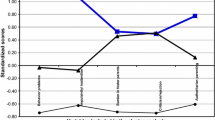Abstract
This study used multiple means to identify 55 young adults who had left foster care in recent years. The young adults who had all emancipated from foster care under the auspices of social services were most often identified by former foster parents, social workers, or other foster youth. This sample of former foster youth are often struggling with ill health, poor educations, severe housing problems, substance abuse, and criminal behavior. Yet the youth in this sample may be surviving more ably than the many former foster youth whom we could not reach.
Similar content being viewed by others
References
Anderson, J. L. & Simonitch, B. (1981). Reactive depression in youths experiencing emancipation.Child Welfare, 60, 383–390.
Arizona Revised Statutes Annotated. Section 8-241 (A) (1) (i), 8-521 (1986).
Barth, R. P. (1986). Emancipation services for adolescents in foster care.Social Work, 31, 165–171.
Barth, R. P. (1989). Programs for interdependent living. In J. Aldate, A. N. Maluccio, & C. Reeves (Eds.),Adolescents in foster families, Chicago, IL: Lyceum Books, Inc.
Barth, R. P. & Berry, M. (1987). Outcomes of child welfare services since permanency planning.Social Service Review, 61, 71–90.
Barth, R. P. & Berry, M. (1988). Child abuse and child welfare services. In M. Kirst (Ed.),Conditions of children in California,. University of California, Berkeley: PACE.
Beyer, M. (1986). Overcoming emotional obstacles to independence.Children Today, 15, 8–12.
Boyd, L. H. Jr. & Remy, L. L. (1978). Is foster-parent training worthwhile?Social Service Review, 52, 275–296.
Chestnut, M. (1985). A survey on emancipation beliefs and practices of social providers. Unpublished manuscript, University of California, Berkeley, School of Social Welfare.
Cook, R., & Ansell, D. I. (1986).Independent living services for youth in substitute care. Prepared for the Administration for Children,. Youth, and Families, U.S. Department of Health and Human Services. Rockville, MD: Westat, Inc., Contract OHOS 105-84-1814.
Erickson, P. I., Rapkin, A. J., Scrimshaw, S. C. M., Long, T. J., Pappas, S. J. & Davis, A. (1987).Multiple risk-taking behavior in middle and high school students in the Los Angeles Metropolitan area. Paper presented at the 115th Annual Meeting of the American Public Health Association, October 18–22, 1987, New Orleans.
Festinger, T. (1983).No one ever asked us New York Columbia University.
Germain, C. B. & Gitterman, A. (1980).The life model of social work practice. New York: Columbia University Press.
Gershenson C. & Kresh, E. (1986). School enrollment status of children receiving child welfare services at home or in foster care.Child Welfare Research Note #15. Washington, D.C.: Office of Human Development Services.
Goldstein, J.: (1975). Why foster care—for whom for how long?Psychoanalytic Study of the Child, 30, 647–662.
Halfon, N. & Klee, L. (1986). Health care for foster children in California. Unpublished monograph available from Institute for Health Policy Studies, University of California, San Francisco, CA.
Jones, M. A. & Moses, B. (1984).West Virginia's former foster children: Their experience and their lives as young adults. New York: Child, Welfare League of America.
Maluccio, A. N. & Fein, S. (1985). Growing up in foster care.Children and Youth Services Review, 7, 123–134.
Mauzerall, H. A. (1983). Emancipation from foster care: The independent living project.Child Welfare, 62, 46–53.
McDermott, V. (1987). Life planning services: Hel** older placed children with their identity.Child and Adolescent Social Work, 3&4, 245–263.
Mech, E. V. & Leonard, E. L. (1988). Volunteers as resources in preparing youth for self-sufficiency.Child Welfare, 67, 595–608.
Mecum, R., & Sepate, J. (1988). New life youth services Creative approaches. In K. G. Mayne (Ed.).Pathways to adulthood (pp. 83–98). Tulsa, OK: National Resource Center for Youth Services.
New York Department of Social Services. (1987). New York Code of Rules and Regulations, 18, Sections 430-12(f) and 430.13(g) Albany, NY: Author.
Oregon Revised Statutes. (1987). Sections 109.550–109.565 and 418.475.
Pettiford, P. M. (1981). Foster care and welfare dependency: A research note. New York: City of New York Human Resources Administration, Robertson, M. J. (1988). Homeless youth in Hollywood. Unpublished report available from Alcohol Research Group Berkeley, CA.
Radloff, L. S. (1977). The CES-D scale: A self-report depresion scale for research in the general population.Applied Psychological Measurement, 1, 385–401.
Shaffer, D. & Caton, C. L. (1984).Runaway and homeless youth in New York City. New York: Division of Child Psychiatry, New York State Psychiatric Institute and Columbia University College of Physicians and Surgeons.
Timberlake, E. M. & Verdieck, M. J. (1987). Psychosocial functioning of adolescents in foster care.Social Casework, 68, 214–222.
Wimpfheimer, R. G. (1986).Aging out: A child welfare dilemma of the 1980s. Dissertation submitted to City University of New York.
Author information
Authors and Affiliations
Additional information
The author thanks Rich Clarke, Pat Lovelock and Sharon Ikami. This study was prepared under Contra Costa County Contract #20-719.
Rights and permissions
About this article
Cite this article
Barth, R.P. On their own: The experiences of youth after foster care. Child Adolesc Soc Work J 7, 419–440 (1990). https://doi.org/10.1007/BF00756380
Issue Date:
DOI: https://doi.org/10.1007/BF00756380



